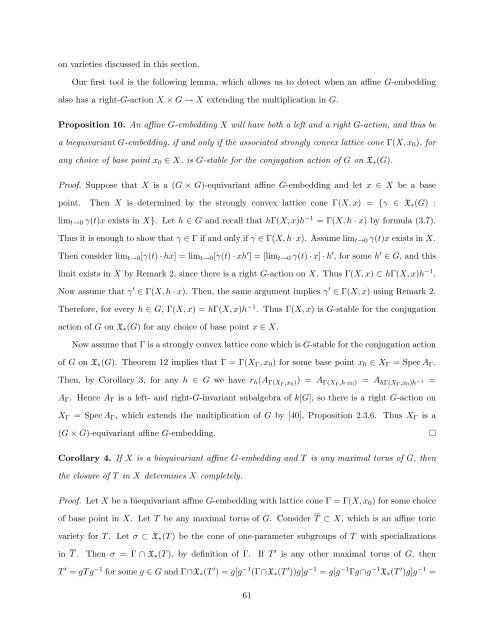Equivariant Embeddings of Algebraic Groups
Equivariant Embeddings of Algebraic Groups
Equivariant Embeddings of Algebraic Groups
You also want an ePaper? Increase the reach of your titles
YUMPU automatically turns print PDFs into web optimized ePapers that Google loves.
on varieties discussed in this section.<br />
Our first tool is the following lemma, which allows us to detect when an affine G-embedding<br />
also has a right-G-action X × G → X extending the multiplication in G.<br />
Proposition 10. An affine G-embedding X will have both a left and a right G-action, and thus be<br />
a biequivariant G-embedding, if and only if the associated strongly convex lattice cone Γ(X, x 0 ), for<br />
any choice <strong>of</strong> base point x 0 ∈ X, is G-stable for the conjugation action <strong>of</strong> G on X ∗ (G).<br />
Pro<strong>of</strong>. Suppose that X is a (G × G)-equivariant affine G-embedding and let x ∈ X be a base<br />
point. Then X is determined by the strongly convex lattice cone Γ(X, x) = {γ ∈ X ∗ (G) :<br />
lim t→0 γ(t)x exists in X}. Let h ∈ G and recall that hΓ(X, x)h −1 = Γ(X, h · x) by formula (3.7).<br />
Thus it is enough to show that γ ∈ Γ if and only if γ ∈ Γ(X, h·x). Assume lim t→0 γ(t)x exists in X.<br />
Then consider lim t→0 [γ(t) · hx] = lim t→0 [γ(t) · xh ′ ] = [lim t→0 γ(t) · x] · h ′ , for some h ′ ∈ G, and this<br />
limit exists in X by Remark 2, since there is a right G-action on X. Thus Γ(X, x) ⊂ hΓ(X, x)h −1 .<br />
Now assume that γ ′ ∈ Γ(X, h · x). Then, the same argument implies γ ′ ∈ Γ(X, x) using Remark 2.<br />
Therefore, for every h ∈ G, Γ(X, x) = hΓ(X, x)h −1 . Thus Γ(X, x) is G-stable for the conjugation<br />
action <strong>of</strong> G on X ∗ (G) for any choice <strong>of</strong> base point x ∈ X.<br />
Now assume that Γ is a strongly convex lattice cone which is G-stable for the conjugation action<br />
<strong>of</strong> G on X ∗ (G). Theorem 12 implies that Γ = Γ(X Γ , x 0 ) for some base point x 0 ∈ X Γ = Spec A Γ .<br />
Then, by Corollary 3, for any h ∈ G we have r h (A Γ(XΓ ,x 0 )) = A Γ(XΓ ,h·x 0 ) = A hΓ(XΓ ,x 0 )h −1 =<br />
A Γ . Hence A Γ is a left- and right-G-invariant subalgebra <strong>of</strong> k[G], so there is a right G-action on<br />
X Γ = Spec A Γ , which extends the multiplication <strong>of</strong> G by [40], Proposition 2.3.6. Thus X Γ is a<br />
(G × G)-equivariant affine G-embedding.<br />
Corollary 4. If X is a biequivariant affine G-embedding and T is any maximal torus <strong>of</strong> G, then<br />
the closure <strong>of</strong> T in X determines X completely.<br />
Pro<strong>of</strong>. Let X be a biequivariant affine G-embedding with lattice cone Γ = Γ(X, x 0 ) for some choice<br />
<strong>of</strong> base point in X. Let T be any maximal torus <strong>of</strong> G. Consider T ⊂ X, which is an affine toric<br />
variety for T . Let σ ⊂ X ∗ (T ) be the cone <strong>of</strong> one-parameter subgroups <strong>of</strong> T with specializations<br />
in T . Then σ = Γ ∩ X ∗ (T ), by definition <strong>of</strong> Γ. If T ′ is any other maximal torus <strong>of</strong> G, then<br />
T ′ = gT g −1 for some g ∈ G and Γ∩X ∗ (T ′ ) = g[g −1 (Γ∩X ∗ (T ′ ))g]g −1 = g[g −1 Γg∩g −1 X ∗ (T ′ )g]g −1 =<br />
61
















